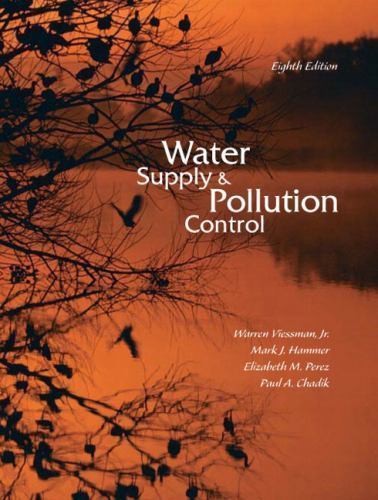Picture 1 of 1

Stock photo

Picture 1 of 1

Stock photo

Water Supply and Pollution Control by Elizabeth Perez, Warren Viessman Jr., Paul Chadick and Sr. Hammer Mark (2008, Hardcover)

AlibrisBooks (476623)
98.8% positive feedback
Price:
$290.23
Free shipping
Returns:
30 days returns. Buyer pays for return shipping. If you use an eBay shipping label, it will be deducted from your refund amount.
Condition:
New Hard cover
Oops! Looks like we're having trouble connecting to our server.
Refresh your browser window to try again.
About this product
Product Identifiers
PublisherPearson Education
ISBN-100132337177
ISBN-139780132337175
eBay Product ID (ePID)63869240
Product Key Features
Number of Pages864 Pages
Publication NameWater Supply and Pollution Control
LanguageEnglish
Publication Year2008
SubjectEnvironmental / Water Supply, Environmental / Waste Management, Environmental / General, Natural Resources
TypeTextbook
Subject AreaNature, Technology & Engineering
AuthorElizabeth Perez, Warren Viessman Jr., Paul Chadick, Sr. Hammer Mark
FormatHardcover
Dimensions
Item Height1.5 in
Item Weight46.2 Oz
Item Length9.5 in
Item Width7.3 in
Additional Product Features
Edition Number8
Intended AudienceCollege Audience
LCCN2009-045395
Dewey Edition22
IllustratedYes
Dewey Decimal628.1
Table Of ContentContents Preface xvii Chapter 1 Introduction 1.1 A Historical Perspective 1.2 A Current Global Issue 1.3 A Look to the Future References Chapter 2 Water Resources Planning and Management 2.1 Environmental Regulation and Protection 2.2 Security of Water Resources Systems 2.3 Watershed Management 2.4 Integrated Watershed Management 2.5 Role of Geographic Information Systems 2.6 Conclusions Problems References Chapter 3 The Hydrologic Cycle and Natural Water Sources 3.1 The Hydrologic Cycle The Water Budget 3.2 Mathematics of Hydrology 3.3 Water Quality 3.4 Soil Moisture Groundwater 3.5 An Introduction to Groundwater Quantity and Quality 3.6 The Subsurface Distribution of Water 3.7 Aquifers 3.8 Safe Yield of an Aquifer 3.9 Groundwater Flow 3.10 Hydraulics of Wells 3.11 Boundary Effects 3.12 Regional Groundwater Systems 3.13 Salt Water Intrusion 3.14 Groundwater Recharge 3.15 Concurrent Development of Groundwater and Surface Water Sources Surface Water 3.16 An Introduction to Surface Water Quantity and Quality 3.17 Surface Water Storage 3.18 Reservoirs 3.19 Losses from Storage 3.20 Impacts of Climate Change on Global Hydrology Problems References Chapter 4 Alternative Sources of Water Supply 4.1 Water Conservation 4.2 Wastewater Reuse 4.3 Stormwater Reuse 4.4 Brackish and Saline Water Conversion 4.5 Interbasin Transfers 4.6 Other Relevant Technologies Problems References Chapter 5 Water Use Trends and Forecasting 5.1 Water-Use Sectors 5.2 Factors Affecting Water Use 5.3 Water Use Trends 5.4 Population 5.5 Long-Term Water Use Forecasting Problems References Chapter 6 Conveying and Distributing Water Hydraulics 6.1 Introduction to Hydraulics 6.2 Uniform Flow 6.3 Gradually Varied Flow and Surface Profiles 6.4 Velocity Water Distribution Systems 6.5 General Design Considerations 6.6 Types of Distribution Systems 6.7 Distribution System Components 6.8 Distribution System Configutations Hydraulic Considerations 6.8 Hydraulic Design Pressure Considerations 6.9 General Design Sequence 6.10 Distribution Reservoirs and Service Storage Pumping 6.11 Pumping Head 6.12 Power 6.13 Cavitation 6.14 System Head 6.15 Pump Characteristics 6.16 Pump Curves Problems References Chapter 7 Wastewater Collection and Stormwater Engineering <p style="MARGIN: 0px
SynopsisThis book provides practicing engineers with water-based environment engineering from theory to practice by presenting the principles of water treatment, wastewater treatment, water reuse, water quality, and overviews of regulations regarding pollution control and drinking water quality. KEY TOPICS: The Eighth Edition features new and updated coverage of GIS, climate change, alternative water supply development, hydraulics, stormwater treatment techniques, water quality regulations, filter design, and more. Recognizing that all waters are potential sources of supply, the authors present treatment processes in the context of what they can do, rather than dividing them along clean water or waste water lines. MARKET: For practicing engineers who need a good reference book and for those preparing to take the examination for licensing as a professional engineer., This book provides practicing engineers with water-based environment engineering from theory to practice by presenting the principles of water treatment, wastewater treatment, water reuse, water quality, and overviews of regulations regarding pollution control and drinking water quality. The Eighth Edition features new and updated coverage of GIS, climate change, alternative water supply development, hydraulics, stormwater treatment techniques, water quality regulations, filter design, and more. Recognizing that all waters are potential sources of supply, the authors present treatment processes in the context of what they can do, rather than dividing them along clean water or waste water lines. For practicing engineers who need a good reference book and for those preparing to take the examination for licensing as a professional engineer. ", For upper-division undergraduate or beginning graduate courses in civil and environmental engineering. The Eighth Edition of this bestselling text has been revised and modernized to meet the needs of today's environmental engineering students who will be engaged in the design and management of water and wastewater systems. It emphasizes the application of the scientific method to problems associated with the development, movement, and treatment of water and wastewater. Recognizing that all waters are potential sources of supply, the authors present treatment processes in the context of what they can do, rather than dividing them along clean water or waste water lines. An abundance of examples and homework problems amplify the concepts presented.
LC Classification NumberTD345
All listings for this product
Ratings and Reviews
Most relevant reviews
- Mar 05, 2017
Textbook
Text book was just as described, shipped in reasonable time and decently priced.Verified purchase: YesCondition: Pre-owned






























